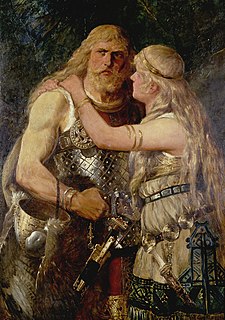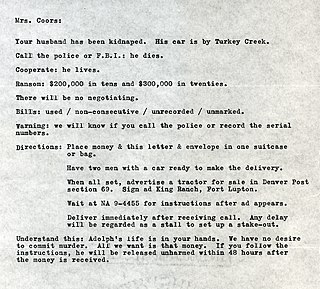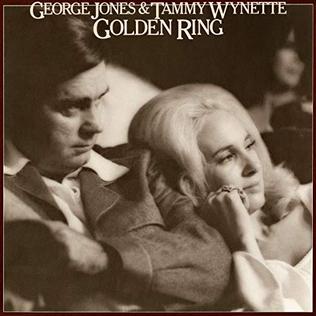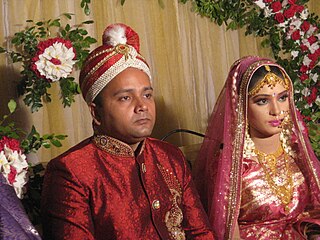Related Research Articles

From the earliest days of the Christian faith, Christians have honored holy matrimony as a divinely blessed, lifelong, monogamous union between a man and a woman. According to the Episcopal Book of Common Prayer (1979), reflecting the traditional view, "Christian marriage is a solemn and public covenant between a man and a woman in the presence of God," "intended by God for their mutual joy; for the help and comfort given one another in prosperity and adversity; and, when it is God's will, for the procreation of children and their nurture." However, while many Christians might agree with the traditional definition, the terminology and theological views of marriage have varied through time in different countries, and among Christian denominations.

Marriage in Judaism is the documentation of a cleansing between a Jewish man and a Jewish woman in which God is involved. In Judaism, a marriage can end either because of a divorce document given by the man to his wife, or by the death of either party. Certain details, primarily as protections for the wife, were added in Talmudic times.

Marriage, also called matrimony or wedlock, is a culturally and often legally recognized union between people called spouses. It establishes rights and obligations between them, as well as between them and their children, and between them and their in-laws. It is considered a cultural universal, but the definition of marriage varies between cultures and religions, and over time. Typically, it is an institution in which interpersonal relationships, usually sexual, are acknowledged or sanctioned. In some cultures, marriage is recommended or considered to be compulsory before pursuing any sexual activity. A marriage ceremony is called a wedding.

A wife is a female in a marital relationship. A woman who has separated from her partner continues to be a wife until the marriage is legally dissolved with a divorce judgement. On the death of her partner, a wife is referred to as a widow. The rights and obligations of a wife in relation to her partner and her status in the community and in law vary between cultures and have varied over time.

Marriage in the Catholic Church, also known as holy matrimony, is the "covenant by which a man and woman establish between themselves a partnership of the whole of life and which is ordered by its nature to the good of the spouses and the procreation and education of offspring", and which "has been raised by Christ the Lord to the dignity of a sacrament between the baptised." Catholic matrimonial law, based on Roman law regarding its focus on marriage as a free mutual agreement or contract, became the basis for the marriage law of all European countries, at least up to the Reformation.
A shotgun wedding is a wedding which is arranged in order to avoid embarrassment due to premarital sex which can possibly lead to an unintended pregnancy. The phrase is a primarily American colloquialism, termed as such based on a stereotypical scenario in which the father of the pregnant bride-to-be threatens the reluctant groom with a shotgun in order to ensure that he follows through with the wedding.

In Islam, nikah is a contract between two people. Both the groom and the bride are to consent to the marriage of their own free wills. A formal, binding contract – verbal or on paper – is considered integral to a religiously valid Islamic marriage, and outlines the rights and responsibilities of the groom and bride. Divorce in Islam can take a variety of forms, some executed by a husband personally and some executed by a religious court on behalf of a plaintiff wife who is successful in her legal divorce petition for valid cause.

Traditional Chinese marriage is a ceremonial ritual within Chinese societies that involves not only a union between spouses, but also a union between the two families of a man and a woman, sometimes established by pre-arrangement between families. Marriage and family are inextricably linked, which involves the interests of both families. Within Chinese culture, romantic love and monogamy was the norm for most citizens. Around the end of primitive society, traditional Chinese marriage rituals were formed, with deer skin betrothal in the Fuxi era, the appearance of the "meeting hall" during the Xia and Shang dynasties, and then in the Zhou dynasty, a complete set of marriage etiquette gradually formed. The richness of this series of rituals proves the importance the ancients attached to marriage. In addition to the unique nature of the "three letters and six rituals", monogamy, remarriage and divorce in traditional Chinese marriage culture are also distinctive.

The Poor Law Amendment Act 1834 (PLAA) known widely as the New Poor Law, was an Act of the Parliament of the United Kingdom passed by the Whig government of Earl Grey. It completely replaced earlier legislation based on the Poor Law of 1601 and attempted to fundamentally change the poverty relief system in England and Wales. It resulted from the 1832 Royal Commission into the Operation of the Poor Laws, which included Edwin Chadwick, John Bird Sumner and Nassau William Senior. Chadwick was dissatisfied with the law that resulted from his report. The Act was passed two years after the 1832 Reform Act extended the franchise to middle class men. Some historians have argued that this was a major factor in the PLAA being passed.

Bride kidnapping, also known as marriage by abduction or marriage by capture, is a practice in which a man abducts the woman he wishes to marry.

Forced marriage is a marriage in which one or more of the parties is married without their consent or against their will. A marriage can also become a forced marriage even if both parties enter with full consent if one or both are later forced to stay in the marriage against their will.

Marriage in ancient Rome was strictly a monogamous institution: a Roman citizen by law could have only one spouse at a time. The practice of monogamy distinguished the Greeks and Romans from other ancient civilizations, in which elite males typically had multiple wives. Greco-Roman monogamy may have arisen from the egalitarianism of the democratic and republican political systems of the city-states. The aspect of a monogamous institution would later be embraced by early Christianity, which in turn perpetuated it as an ideal in later Western culture.

Marriage is available in England and Wales to both opposite-sex and same-sex couples and is legally recognised in the forms of both civil and religious marriage. Marriage laws have historically evolved separately from marriage laws in other jurisdictions in the United Kingdom. There is a distinction between religious marriages, conducted by an authorised religious celebrant and civil marriages conducted by a state registrar. The legal minimum age to enter into a marriage in England and Wales is eighteen years. Certain relatives are not allowed to marry. For foreign nationals, there are also residency conditions that have to be met before people can be married. Same-sex marriage was introduced under the Marriage Act in March 2014.

Golden Ring is the seventh studio album by American country music artists George Jones and Tammy Wynette, released in August 1976 on the Epic Records label. It reached No. 1 on the Billboard Country Album chart. The singles "Near You" and "Golden Ring" both reached No. 1 on the Country Singles chart.

Lee Baldwin is a fictional character on the daytime dramas General Hospital and Port Charles.
Knobstick may refer to:

Muslim marriage and Islamic wedding customs are traditions and practices that relate to wedding ceremonies and marriage rituals prevailing within the Muslim world. Although Islamic marriage customs and relations vary depending on country of origin and government regulations, both Muslim men and women from around the world are guided by Islamic laws and practices specified in the Quran.

Bride price, bride-dowry, bride-wealth, or bride token, is money, property, or other form of wealth paid by a groom or his family to the woman or the family of the woman he will be married to or is just about to marry. Bride dowry is equivalent to dowry paid to the groom in some cultures, or used by the bride to help establish the new household, and dower, which is property settled on the bride herself by the groom at the time of marriage. Some cultures may practice both simultaneously. Many cultures practiced bride dowry prior to existing records.
In Japan, the slang term Dekichatta kekkon (出来ちゃった結婚), or Dekikon (デキコン) for short, emerged in the late 1990s. The term can literally be translated as "oops-we-did-it-marriage," implying an unintended pregnancy. Notable celebrities with these marriages include Namie Amuro, Yōko Oginome, Hitomi Furuya, Ami Suzuki, Kaori Iida, Nozomi Tsuji, Anna Tsuchiya, Meisa Kuroki, Leah Dizon, Melody Miyuki Ishikawa, Riisa Naka and Rie Miyazawa. A quarter of all Japanese brides are pregnant at the time of their wedding, according to the Health Labor and Welfare Ministry, and pregnancy is one of the most common motivations for marriage. The prevalence and celebrity profile of dekichatta-kon has inspired Japan's wedding industry to introduce an even more benign phrase, sazukari-kon.
A marry-your-rapist law, marry-the-rapist law, or rape-marriage law is a rule of rape law in a jurisdiction under which a man who commits rape, sexual assault, statutory rape, abduction or other similar act is exonerated if he marries his female victim, or in some jurisdictions at least offers to marry her. The "marry-your-rapist" law is a legal way for the accused to avoid prosecution or punishment.
References
- 1 2 3 Brewer, E. Cobham (31 August 2012). Dent, Susie (ed.). Brewer's Dictionary of Phrase and Fable . Chambers Harrap Publishers. p. 756. ISBN 978-0550102454.
- ↑ Chambers, Jonathan David (1966). Nottinghamshire in the Eighteenth Century: A Study of Life and Labour Under the Squirearchy. F. Cass. p. 291. ISBN 0714612855.
- 1 2 Vanderpool Gormley, Myra (19 November 1987). "'Knobstick Wedding', Shotgun Variety". Los Angeles Times . Retrieved 1 October 2013.
- 1 2 "Knobstick Wedding". Wirksworth.org.uk. Retrieved 1 October 2013.
- ↑ "Newsletter No. 143" (PDF). Institute of Heraldic and Genealogical Studies. July 2013. p. 8. Archived from the original (PDF) on 4 October 2013. Retrieved 1 October 2013.
- ↑ "Series K, Episode 4 – Knits and Knots". QI. Retrieved 1 October 2013.
- 1 2 "Tom Otter – Fact or Folklore?". Saxilby and District History Group. Archived from the original on 5 October 2013. Retrieved 1 October 2013.
- 1 2 "How the Black Country couples used to 'put the beans to bile'". Black Country Bugle. 21 June 2013. Retrieved 1 October 2013.